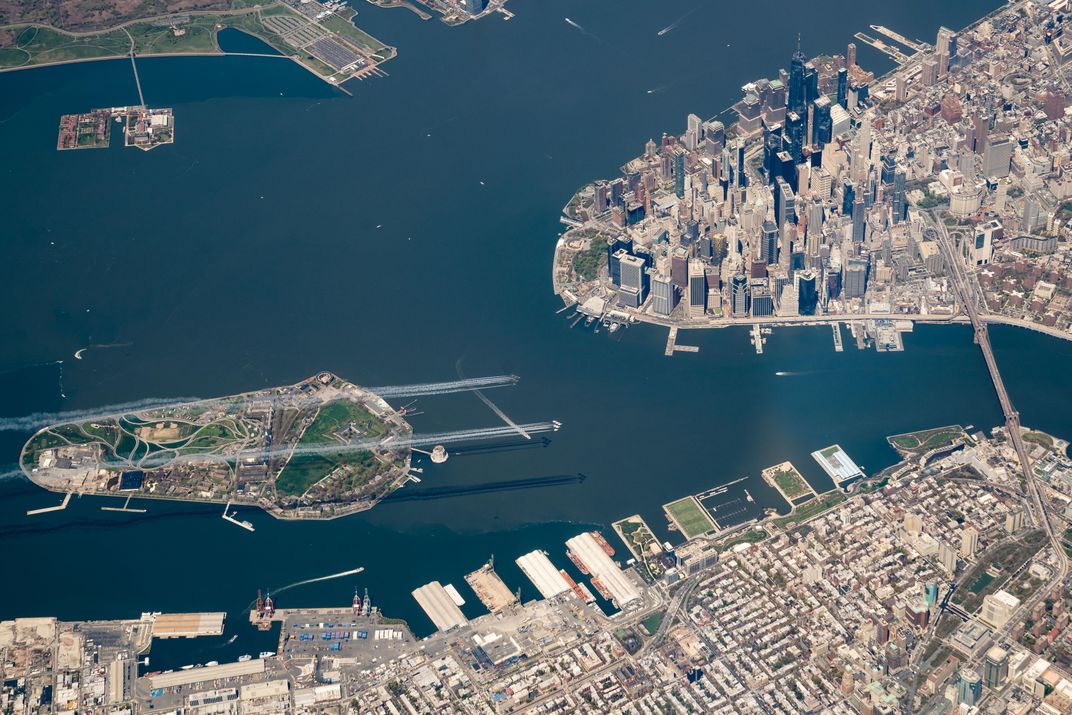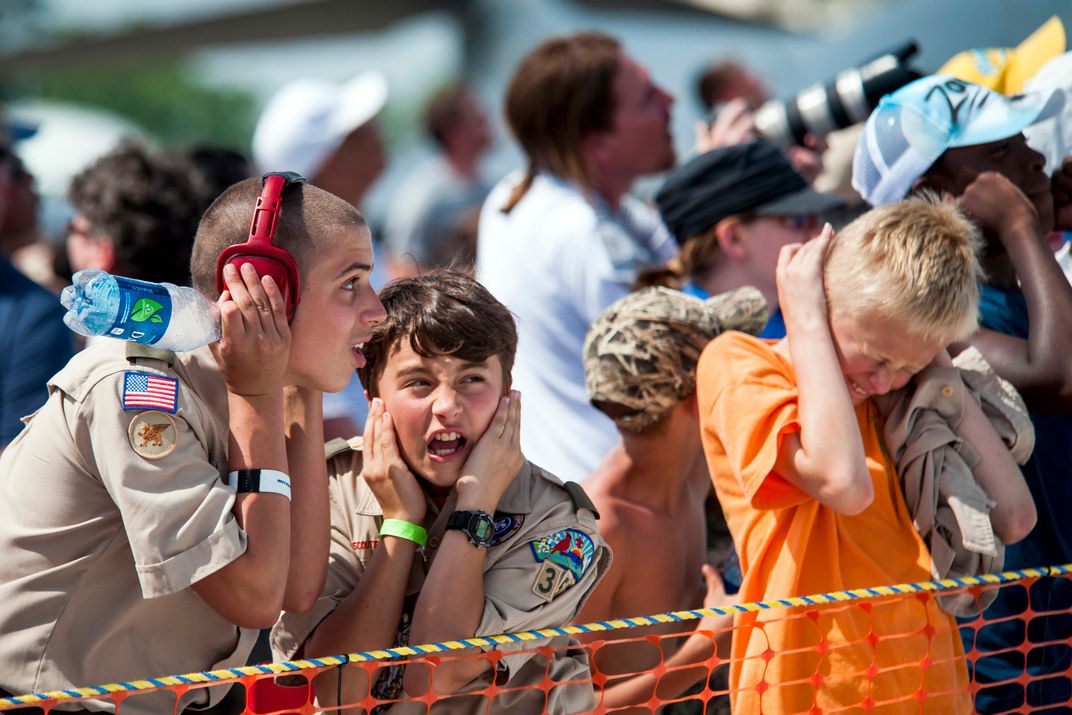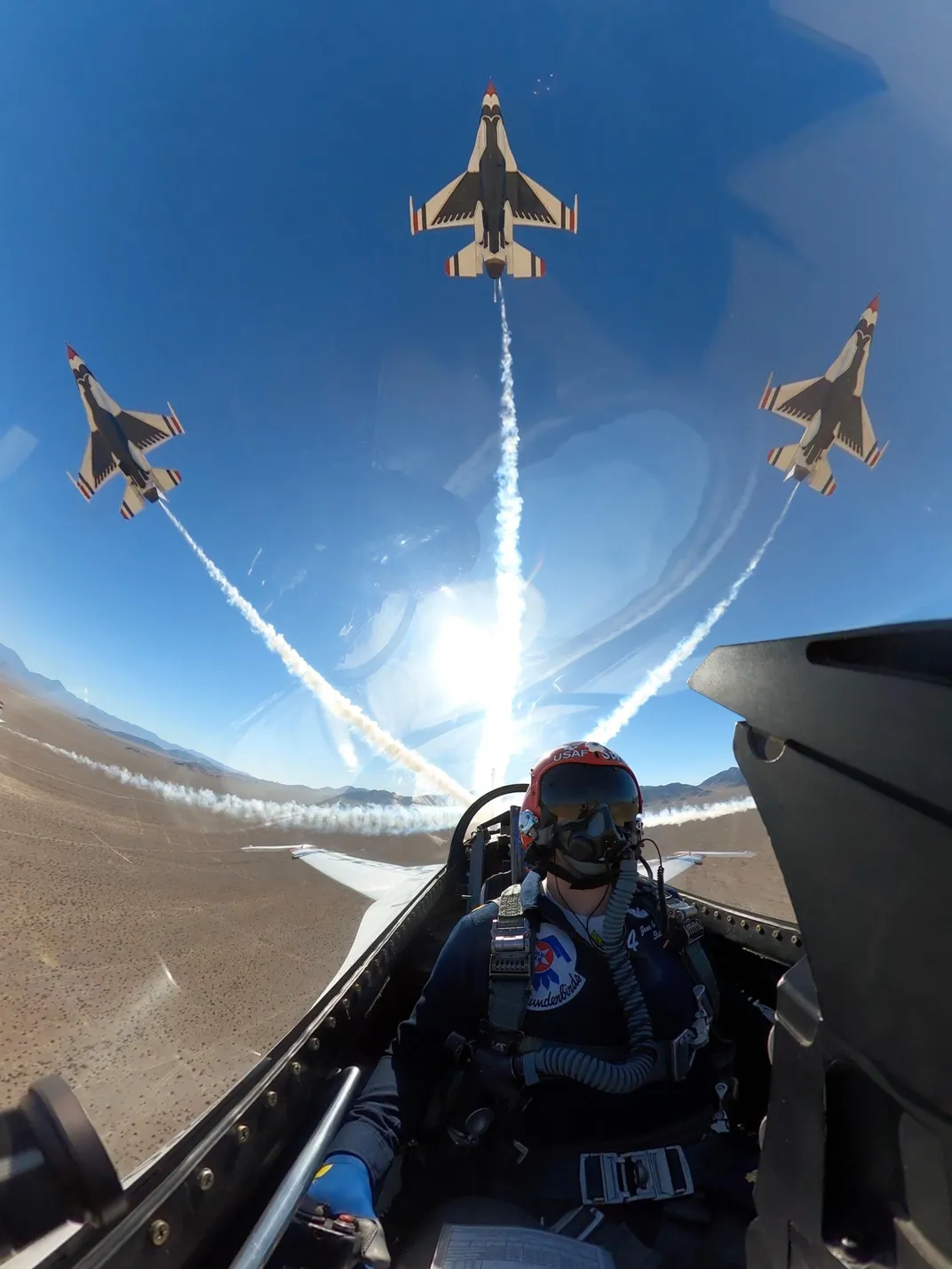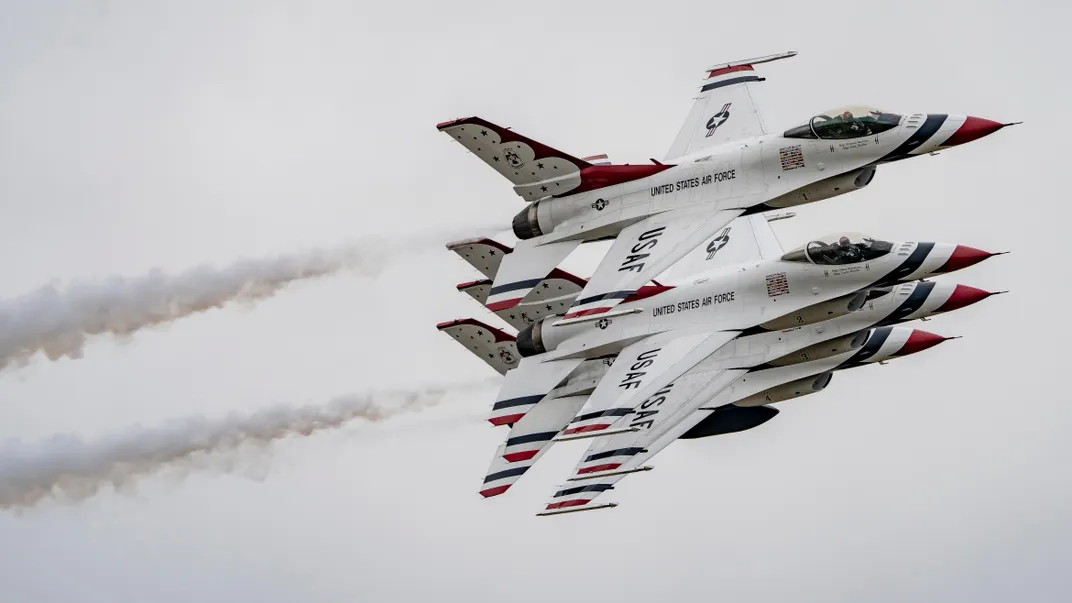The Thunderbirds Are Back With a New, More Crowd-Friendly Routine
And at some airshows this season, they’ll be teaming up with the Blue Angels.
:focal(2029x1091:2030x1092)/https://tf-cmsv2-smithsonianmag-media.s3.amazonaws.com/filer/a1/13/a113f07e-9502-4c06-a24e-54558211afaa/0_super_delta_6539854_copy.jpg)
After sitting out most of last year’s airshow season due to the pandemic, the U.S. military’s premier aerial performance teams—the Air Force Thunderbirds and the Navy Blue Angels—are coming back even stronger for the 2021 season, which gets into full swing this month.
Both teams were grounded from on-site performances last summer, and were limited to flyovers of major cities. But they used the down time to swap ideas and best practices, resulting in new routines—including a new joint formation that will have the aircraft flying closer to each other than at any point in their history. The Thunderbirds also will introduce the first major revision to their performance since 1983, when the team switched from flying T-38s to F-16s.
On Memorial Day weekend, the teams plan to assemble over Washington, D.C. for the first public display of the joint formation dubbed the Super Delta, during the televised National Memorial Day Parade. The teams perfected the new routine in March during joint training at Naval Air Facility (NAF) El Centro, California. The Super Delta draws a tight “V” consisting of six Thunderbird F-16C Fighting Falcons and six Blue Angels F/A-18 Super Hornets.
In previous joint flyovers, including last year’s America Strong tour to honor healthcare workers and others combating the pandemic, the Thunderbirds and Blue Angels flew separate formations in parallel, while leaving a safety buffer of open sky between them. In their individual performances, each team flies their aircraft as close as 18 inches apart, but the Super Delta formation of dissimilar aircraft will keep a separation of 36 inches.

Major Kyle Oliver is the new Thunderbird slot #6 this season, flying the boldest and fastest solo maneuvers. He also serves as the squadron Flight Safety Officer. For the Super Delta formation, the Blue Angels are at center while the Thunderbirds form the outer rung or echelon. Oliver notes that adding more pairs of aircraft radiating from the center of the standard “V” complicates handling. “Each [additional] aircraft gets more difficult to fly, the differences amplify, and the more unstable the formation. You need a safety buffer [of at least three feet].”
The Thunderbirds debuted their own new routine this April over Cocoa Beach, Florida. Current and former members of the team and their support staff had spent much of last year consulting with the International Council of Air Shows (ICAS) and former employees of Disney to determine what airshow fans might want, and how to deliver more punch in less time.

An exhaustive remix of the old show led to cutting the run time from 75 minutes to a combined ground and aerial performance running just 50 minutes. Redundant maneuvers were tossed out, and two new ones added. The music and choreography were both updated.
In their last full season, the Thunderbirds performed different shows depending on weather and cloud height at the airshow site. For a “high” show, the flying altitude was unrestricted, allowing for such maneuvers as a bomb burst or a vertical climb. Low shows were limited to maneuvers that could be executed safely below the clouds to ensure visibility. Flat shows featured maneuvers with little or no change in altitude.
Commander John D. Caldwell, the Thunderbirds team leader flying the #1 (lead) position, said that revamping the team’s performance began by cutting 15 minutes from the high show, which not only had pushed the F-16’s tank capacity nearly to the point of “landing on fumes,” but also had tested the limits of the crowd’s attention span.
“It’s easy to make a show longer by adding demos, but harder to cut things out,” Caldwell says. In the new shows, regardless of the local cloud ceiling, airshow fans will see 90 percent of the team’s aerial moves.
The shorter show means that fans will see ten minutes less of the Thunderbirds’ ground crew. That segment has been revised to highlight the real actions of Air Force support teams in a combat theater. Caldwell says the condensed sequence is no longer just a series of maneuvers, but “actually communicates something.” Captain Mike Bell, Thunderbird #11, says the emphasis on support teams also helps with recruitment. For a general audience, it shows that “if you like servicing your car [or] mastering your computer, the Air Force has a place for you.”
Major Zane Taylor, a second-year Thunderbird pilot now flying position #3 (right wing), says re-designing the performance started with the crowd’s reaction and worked backward from there. “Disney has been doing this so long they basically have a mold,” he says. The Air Force consulted with former employees of Disney “at length,” and concluded that the Thunderbirds’ performance needed to follow a series of arcs with a varying pace, rather than just constantly bombarding the senses.
While airshow organizers typically like including military jet demonstrations since they drive attendance, Caldwell says that some members of ICAS would like to shorten the temporary flight restrictions to the airport’s regular traffic and the surrounding airspace, and leave more time for other kinds of performers.
Bell and other team members also think the streamlined presentation may be better for audiences watching online. This year the Blue Angels tried their first radio broadcast of an airshow for fans living near NAF El Centro. The main thing is to appeal to modern audiences. Caldwell says the new display takes a page from Cirque du Soleil. “We pair the music and narration to tell the person where to look,” to sync with the fans’ emotions.
Taylor says the team used “intelligent design principles to determine where a fan’s eyes are focused. The show begins with a “high-alpha” slow pass—the most time-consuming of the maneuvers—then “resets your temporal perspective” by progressing to faster moves with afterburner.
The Thunderbirds also have added two maneuvers. For the “Stinger Break Cross,” a solo jet flown by Oliver loops away trailing smoke, then vanishes as the crowd’s eyes stay glued to the formation at show center. “It’s designed so the crowd forgets about me,” says Oliver, whose F-16 zooms off beyond the spectators’ field of view. “Then I turn smoke off and time my entry [into the maneuver] to sneak in at 500 feet above ground level, just shy of the speed of sound. I think it’s a pretty big moment for the crowd,” he adds in an aww-shucks manner.
The “Low Bomb Burst Hit” is a modified version of the traditional maneuver where aircraft climb to a starburst pattern—as depicted in the Air Force Memorial sculpture looming over the Pentagon in Arlington, Virginia.
To perfect the joint Super Delta maneuver, the Thunderbirds spent four days in El Centro coordinating with the Blue Angels, and even adopted some of the Navy team’s communications practices. For example, says Oliver, “You now hear the Thunderbirds Boss say ‘Stand by boards.’ ” The Blue Angels use air brakes, often called speed brakes, to manage the aircraft energy. “We call speed brakes “boards” because they are sheets of metal which open into the wind and then close back,” says Oliver. The Thunderbirds hadn’t used brakes during their display before starting to work with the Blue Angels.
The Thunderbirds have a full schedule planned for 2021. As for the Blue Angels, in their 75th year of performances they’ll be flying new F/A-18E/F Super Hornets instead of the legacy Hornets they have flown since retiring the A-4F Skyhawk in 1986. As for their schedule, they’ll return to the same one they released in 2019, which had to be shelved due to the pandemic.

